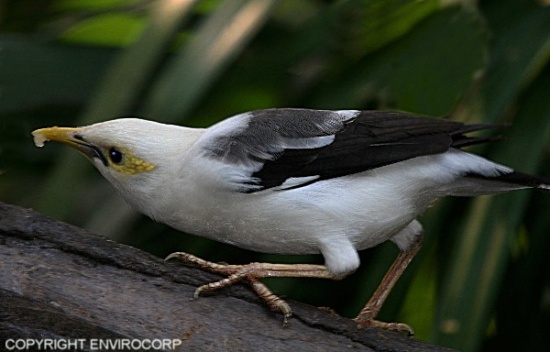Alternative names: Black-winged Myna; White-breasted Starling
- Acridotheres melanopterus
Sturnus melanopterus
Identification
23cm. A small Starling with a striking black-and-white plumage:
- White plumage
- nominate with white mantle and upperparts, tricolor with grey back and black upperwing-coverts, tertius with grey mantle to uppertail-coverts and black upperwing-coverts
- Black wings with white wing patch
- Black tail with white tips
- Bare yellow skin around eye
- Yellowish-orange bill, horn legs and feet
Sexes similar. Juveniles are grey from crown to back.
Distribution
Found in Indonesia in the lowlands of Java, Bali and Lombok (where status unclear, only few records known).
The nominate race has been introduced in Singapore.
A rare and local species.
Taxonomy
Often placed in genus Sturnus.
May form a superspecies with other members of the genus.
Subspecies
Three subspecies recognized[1]:
- A. m. melanopterus on Java (expect southeast) and Madura Island
- A. m. tricolor in southeast Java
- A. m. tertius on Bali, Nusa Penida and Lombok
Some authorities treat this species as monotypic[1].
Habitat
Dry and rainforests, shrubland, and pastures and grassland at low elevations. Occurs up to 1300m, occasionally recorded higher.
Behaviour
Forms roosts in tall trees, sometimes associated with Bali Myna.
Diet
Feeds on fruit, nectar and insects.
Forages in pairs or small flocks in trees and on the ground.
Breeding
Breeding season in January and from March to May in Java, February (and partly also June) in Bali. Presumed to be monogamous. The nest is placed in a rock hole or a tree hole. Lays 3 - 4 eggs.
Movements
A resident species.
References
- Clements, J. F., T. S. Schulenberg, M. J. Iliff, T. A. Fredericks, J. A. Gerbracht, D. Lepage, S. M. Billerman, B. L. Sullivan, and C. L. Wood. 2022. The eBird/Clements checklist of Birds of the World: v2022. Downloaded from https://www.birds.cornell.edu/clementschecklist/download/
- Del Hoyo, J, A Elliott, and D Christie, eds. 2009. Handbook of the Birds of the World. Volume 14: Bush-shrikes to Old World Sparrows. Barcelona: Lynx Edicions. ISBN 978-8496553507
- BirdLife International
Recommended Citation
- BirdForum Opus contributors. (2024) Black-winged Myna. In: BirdForum, the forum for wild birds and birding. Retrieved 19 April 2024 from https://www.birdforum.net/opus/Black-winged_Myna
External Links
GSearch checked for 2020 platform.1




